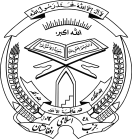
Back الحزب الاسلامى قلب الدين ARZ Hizb-e-İslami Gülbəddin Azerbaijani Hizb-i Islāmī (Hekmatyār) German Χεζμπ-ε Ισλαμί Γκουλμπουντίν Greek حزب اسلامی گلبدین حکمتیار Persian Hezb-e-Islami Gulbuddin French חיזב-י אסלאמי גולבודין HE Hezb-e Islami Gulbuddin ID 굴부딘 이슬람당 Korean Partia Islamska (frakcja Hekmatjara) Polish
| Hezb-e Islami Gulbuddin | |
|---|---|
| حزب اسلامی گلبدین | |
 | |
| Leaders | Gulbuddin Hekmatyar |
| Dates of operation | 1976–2016 (as a Paramilitary organization) 1976–present (as a political party) |
| Group(s) | Zafar brigade |
| Active regions | Afghanistan |
| Ideology | Islamism[1] Pashtun interests Anti-Salafi[2] |
| Political position | Right-wing |
| Size | 1,500–2,000+ (2015 estimate)[3] |
| Part of | |
| Allies | Non-state Allies: |
| Opponents | Non-state Opponents: |
| Battles and wars | Soviet–Afghan War Afghan Civil War (1989–92) Afghan Civil War (1992–96) Afghan Civil War (1996–2001) War in Afghanistan (2001–2021) |
| Flag |  |
The Hezb-e-Islami Gulbuddin (Persian: حزب اسلامی گلبدین; abbreviated HIG), also referred to as Hezb-e-Islami[5] or Hezb-i-Islami Afghanistan (HIA),[6] is an Afghan political party and paramilitary organization, originally founded in 1976 as Hezb-e-Islami and led by Gulbuddin Hekmatyar. In 1979, Mulavi Younas Khalis split with Hekmatyar and established his own group, which became known as Hezb-i Islami Khalis; the remaining part of Hezb-e Islami, still headed by Hekmatyar, became known as Hezb-e Islami Gulbuddin. Hezbi Islami seeks to emulate the Muslim Brotherhood and to replace the various tribal factions of Afghanistan with one unified Islamic state. This puts them at odds with the more tribe-oriented Taliban (which is predominantly Pashtun).[7]
During the Soviet–Afghan War (1979–1989), Hezb-e Islami Gulbuddin was well-financed by anti-Soviet forces through the Pakistani Inter-Services Intelligence (ISI). In the mid-1990s, the HIG was "sidelined from Afghan politics" by the rise of the Taliban. In the post-2001 war in Afghanistan, HIG "reemerged as an aggressive militant group, claiming responsibility for many bloody attacks against Coalition forces and the administration of President Hamid Karzai".[6] Its fighting strength was "sometimes estimated to number in the thousands".[8] The group signed a peace deal with the Ghani administration in 2016.
Following the collapse of the Islamic Republic of Afghanistan, on 17 August 2021, Hekmatyar met with both Karzai, former President of Afghanistan, and Abdullah Abdullah, Chairman of the High Council for National Reconciliation and former Chief Executive, in Doha seeking to form a government (though it was unclear whether either Karzai or Abdullah would be directly involved in any such government).[9][10] President Ashraf Ghani, having fled the country to either Tajikistan or Uzbekistan, emerged in the UAE and said that he supported such negotiations and was in talks to return to Afghanistan.[11][12]
- ^ Lansford, Tom (2012). 9/11 and the Wars in Afghanistan and Iraq. Abc-Clio. ISBN 9781598844191. Retrieved 6 February 2015.
- ^ Dorronsoro, Gilles (2005). Revolution Unending. Afghanistan: 1979 to the present. London: Hurst. p. 231. ISBN 1-85065-703-3.
- ^ Gunaratna, Rohan; Woodall, Douglas (January 16, 2015). Afghanistan after the Western Drawdown. Rowman & Littlefield. ISBN 9781442245068. Retrieved 13 August 2015.
- ^ "Afghanistan war logs reveal hand of Osama bin Laden". TheGuardian.com. 26 July 2010.
- ^ Cite error: The named reference
Schismwas invoked but never defined (see the help page). - ^ a b Cite error: The named reference
Jamestownwas invoked but never defined (see the help page). - ^ Seth Jones, "The Rise of Afghanistan's Insurgency: State Failure and Jihad", International Security, vol 32, no. 4 (2008) pages 28–29
- ^ Cite error: The named reference
crowleywas invoked but never defined (see the help page). - ^ "Afghanistan's Hekmatyar says heading for Doha with Karzai, Abdullah Abdullah to meet Taliban - Al Jazeera". Reuters. 2021-08-16. Retrieved 2021-08-18.
- ^ AFP (2021-08-18). "Taliban met ex-Afghan leader Karzai, Abdullah Abdullah". Brecorder. Retrieved 2021-08-18.
- ^ Macias, Natasha Turak,Amanda (2021-08-18). "Ousted Afghan President Ashraf Ghani resurfaces in UAE after fleeing Kabul, Emirati government says". CNBC. Retrieved 2021-08-19.
{{cite web}}: CS1 maint: multiple names: authors list (link) - ^ "Ghani says he backs talks as Taliban meet with Karzai, Abdullah". New Age. Retrieved 2021-08-18.